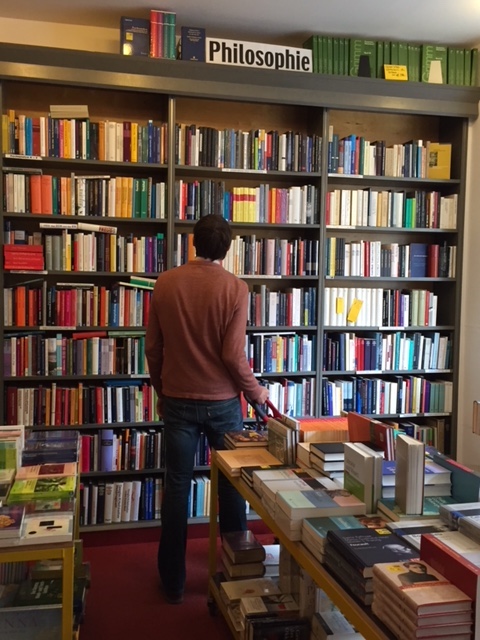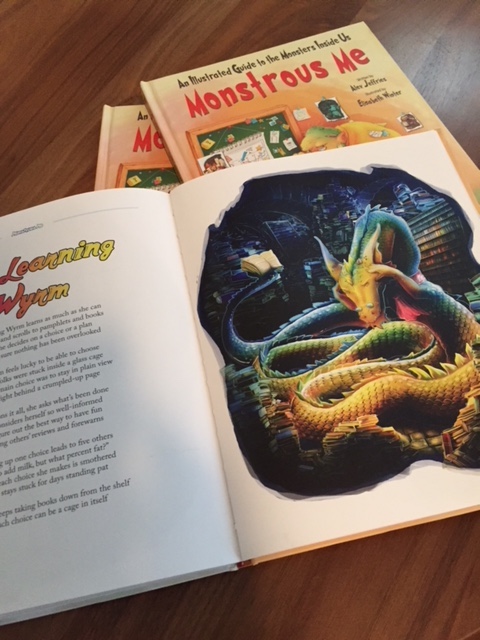Christopher perusing the “Philosophie” section of a used book store in Berlin.
Reading is such an integral part of my days that it often surprises me when I look back and review the list of books read in any particular year. Sometimes, my focus is intentional, informed by current interests; other times, recommendations from friends and colleagues steer the direction of my reading; still again, I chose deliberatively from well-respected authors or subjects in a particular period. 2017 was no exception; although the break-down between fiction and non-fiction books was similar to 2016, the focus was slightly different.
Women: Well-researched, these hidden histories of mathematicians, measurers of stars, and workers in radium factories formed a cornerstone underpinning what it means to be a female working in America during the past century and a half: “The Glass Universe, How the Ladies of the Harvard Observatory Took the Measure of the Stars”, Dava Sobel (if you haven’t read some of her other works, like “Galileo’s Daughter” and “Longitude, you should); “Hidden Figures: The Story of the African-American Women Who Helped Win the Space Race,” Margot Lee Shetterly; and “The Radium Girls: The Dark Story of America’s Shining Women,”by Kate Moore. Women have traditionally been the keepers of our homes, but this book might persuade you to think more broadly about what “home” means, “Home: A Short History of an Idea,” Witold Rybczynski.
One of my favorite Latin writers, Isabel Allende, writes of a mother’s love for her daughter, poignant and protective, during a time of crisis. Her memoirs expand the definition of family to the concept of one’s “tribe,” something I miss with my small nuclear family scattered across the United States: “Paula” and a memoir of the years after Paula’s death, “The Sum of Our Days.” Expanding the family theme and what it means in a time of terror with so many unknowns, “Avenue of Spies, a True Story of Terror, Espionage and One American Family’s Heroic Resistance in Nazi-occupied Paris”, by Alex Kershaw, takes us back to World War II in France. Although fiction, this book, too, hails women heroes in France during that same time period: “Lilac Girls,” by Martha Hall Kelly.
Another strong woman, Tricia Downing overcame a horrific accident to show us courage and perseverance: “Cycle of Hope, A Journey from Paralysis to Possibility.” Anne Lamott discusses alcoholism and faith once again in her latest book, “Hallelujah Anyway: Rediscovering Mercy.”
Science and Health: My list always includes books related to science, nature, and health. Even in their diversity I find knowledge and information to guide me in my daily life. My favorites: “The Book of Joy: Lasting Happiness in a Changing World,” The Dalai Lama, Desmond Tutu; “First Bite, How We Learn to Eat,” Bee Wilson; “The Case Against Sugar,” Gary Taubes; “The Hour of Land: A Personal Topography of America’s National Parks,” Terry Tempest Williams (exquisite essays about Ms. Williams’ personal connection to a number of our national parks and an homage to their beauty and uniqueness); “The Gene: An Intimate History,” Siddhartha Mukherjee; “The Forest Unseen: A Year’s Watch in Nature,” David George Haskell; and “Savannah Diaries,” Brian Jackman (read in anticipation of our trip to Kenya, cancelled unfortunately, but a vivid description of Africa thirty years ago).
Other Non-Fiction: Several other books caught my attention, whether because I attended a local concert or author presentation or on my book club’s reading list, these formed the remaining non-fiction books I read in 2017: “Grieving Dad, Surviving and Healing the Loss of Your Child,” Mark Seidman; “Beethoven for a Later Age: Living with the String Quartets,” Edward Dusinberre; “A Long Way Home,” Saroo Brierley; “Books for Living,” Will Schwalbe (also author of “The End of your Life Book Club,” which I thoroughly enjoyed (and which helped form my reading list) ; and “White Trash: The 400-Year Untold History of Class in America,” Nancy Isenberg.
Grandson Solomon at the library, starting young!
Fiction: Fiction covered a broad swath of topics, from a project for well-known authors to “re-write” a Shakespeare play (here, in “Hag-seed,” Margaret Atwood re-imagined “The Tempest”); to follow-on books by favorite authors, e.g., “The Plague of Doves,” by Louise Erdrich; “Swing Time,” by Jadie Smith; “The Abundance: Narrative Essays, Old and New,” Annie Dillard; “The Farming of Bones,” by Edwidge Danticat; “Song of Solomon,” by Toni Morrison; “The Cat’s Table,” Michael Ondaatje; “A Gentleman in Moscow,” by Amor Towles; and “Fresh Complaint,” by Jeffrey Eugenides; and “must-reads” or sometimes “re-reads” of important books of our time (or to try to explain these times), including “1984,” by George Orwell (which, upon re-reading, one finds it is much richer and more evil than merely the concept turned reality that “Big Brother” is watching us); “The Love in the Time of Cholera,” Gabriel Garcia Marquez (a focus in 2017 on magical realism it seems!); and two very different books about the mid-nineteenth century, “The Underground Railroad,” by Colson Whitehead; and “Lincoln in the Bardo,” by George Saunders.
Miscellaneous Fiction: I read a variety of other fiction works, whether based on friends and family members’ recommendations, Boulder Book Store staff recommendations, or books prominent on displays at airport shops: they range from books about the West to science fiction to historical fiction: “Before the Fall,” Noah Hawley; “Call Me by Your Name,” Andre Aciman; “News of the World,” Paulette Jiles; “Arrival (Stories of Your Life),” Ted Chiang; “The Story of Lucy Gault,” William Trevor; “We Were Liars,” E. Lockhart; “Station Eleven: A Novel,”” Emily St. John Mandel; “Homegoing,” Yaa Gyasi; “Night Prayers,” Santiago Gamboa; “The Garden of Evening Mists,” Tan Twan Eng; “The Sympathizer,” Viet Thanh Nguyen; “The Blackwater Lightship,” Colm Toibin; and “The Pope’s Daughter,” Dario Fo.
Alex’s “Monstrous Me” in full color!
The year’s book list would not be complete without mentioning the two books written by my son, Alex Jeffries: “Monstrous Me: An Illustrated Guide to the Monsters Inside Us,” the result of his successful (first) Kickstarter campaign, a book billed for young adults and children but which contains lessons to be learned about many of our own quirks and qualities: and “Solomon the Very Tall Boy,” a book written with love to our grandson, his nephew, about a little boy who dreams to be big.
I started 2018 re-reading “Americanah,” by Chimamanda Ngozi Abichie (which, by the way, is even more compelling the second time), for a new book club. This year promises to be rich in words, sentences, paragraphs, and chapters!


